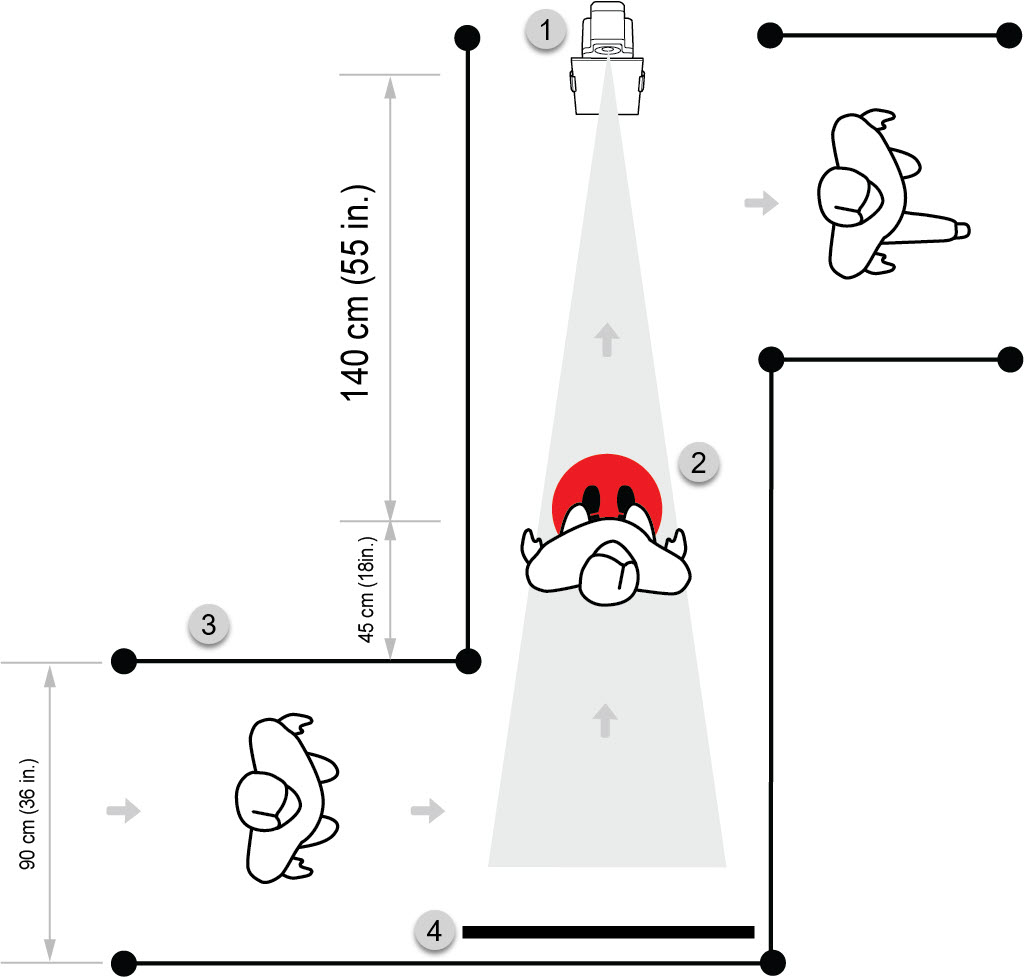7 Description — Screening station
This chapter describes the FLIR EST Kiosk screening station.
7.1 Overview
The screening station consists of the FLIR EST Kiosk, a clearly defined screening position, and a queueing system.
The FLIR EST Kiosk measures the temperature around the tear duct of the screened person, analyzes the measured temperature, and displays a screening
result.
For improved measurement accuracy, it is important that the screened person is at the correct distance from the FLIR EST Kiosk. The screening position indicates where the person should stand for the screening.
For an efficient screening flow, a queueing system is needed to guide the visitors into the screening station, to the correct
screening position, and out of the screening station. A backdrop may be needed to prevent background disturbances from reaching
the camera.
7.2 Typical setup

Figure 7.1 Typical screening station setup
- FLIR EST Kiosk.
-
Screening position.
It is important to clearly mark where the person shall stand for the screening. This is called the screening position. The face of the screened person should be at the center of the screening position.
The screening position shall be perpendicular to the FLIR EST Kiosk camera, so that the screened person directly faces the camera. The distance from the foot of the FLIR EST Kiosk stand to the center of the screening position shall be 120 cm (47 in.).- For accurate temperature measurements, it is important that the thermal camera focus is correct. With a fixed screening position, the focus can be adjusted once and for all during the setup of the screening station (no need to adjust the focus for every screened person).
Explanation: -
Queueing system, e.g. barriers and arrow floor stickers.
The queueing system will guide the visitors into the screening station, to the correct screening position, and out of the screening station. A recommended standard is to keep the queue at least 90 cm (36 in.) wide. To make sure people do not cut the corner and end up too close to the FLIR EST Kiosk, about 45 cm (18 in.) should be added to the barrier leading in to the screening station. -
Optional: Backdrop.
The camera should only see the screened person, no other people in the background. This can be achieved by placing a backdrop behind the screening position.
-
Optional: Operator display.
Secondary display placed near the operator for monitoring. -
Optional: Information roll-up.
Roll-up that informs people what the screening is about and why they need to do it. -
Optional: Instruction roll-up.
Roll-up that tells people to remove eyeglasses before they are screened.
Additional, not in the figure:
7.3 Screening station considerations
For accurate screening results and an efficient screening flow, the following factors related to the screening station area
should be considered.
- Allow time for people to acclimatize their temperature to the ambient temperature at the screening station. The measurements improve quickly, but the longer acclimatization time the better.
- Allow for people to stabilize their temperature if it was raised by exercise or physical activity.
- The person to be screened should not be sweating, since that changes the skin temperature.
- Screening is best with room temperatures maintained below 24°C (76°F) and relative humidity below 50 %.
- Screening should be carried out in an area with no air movement, out of direct sunlight, and away from heat sources.
- Avoid locations with reflective backgrounds (e.g. windows, glass doors, or metallic surfaces).
Screening accuracy
- The FLIR EST Kiosk is intended for indoor use.
- The FLIR EST Kiosk shall preferably be placed so that the operator can see the screening station and be of guidance to the screened persons.
- It can be useful to have a secondary display for the operator, e.g. on the reception desk.
- Power outlets are needed for the FLIR EST Kiosk and any operator display.
- Avoid reflections in the tablet screen. Otherwise, it can be difficult for the visitors to see the graphics and messages on the screen.
Equipment
- Plan how the visitors will flow into the screening station and out, both in low and high flow periods. Plan for any alternative routes, e.g. after an alarm, for any questions, for persons in a wheelchair or with other special requirements.
- Consider personal integrity matters; e.g. if the FLIR EST Kiosk should be hidden from others than the screened person. See also section 7.4 Company policies .
- Allow for appropriate distancing between people in the screening queue.
Visitors and queueing
7.4 Company policies
The FLIR EST Kiosk only detects elevated skin temperatures. It is up to your company to set up a suitable screening process in accordance with
applicable local data protection, employment, and health & safety laws.
-
Personal integrity
Make decisions on how to handle personal integrity, e.g. show/hide the FLIR EST Kiosk for others than the screened person, have/not have a sound alarm, save/not save image and data when an alarm is triggered.
-
Process for alarms
Establish a process for those individuals where the system has indicated an elevated temperature, e.g. let the person sit down for 10 minutes and then do the screening again, further evaluation by medically trained personnel.
-
Visitor information
Provide visitors with information and instructions about the screening, e.g. by roll-ups and FLIR EST Kiosk symbols and messages.
These are some of the factors your company need to consider: